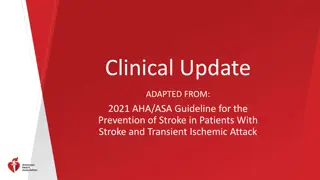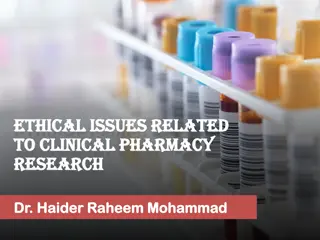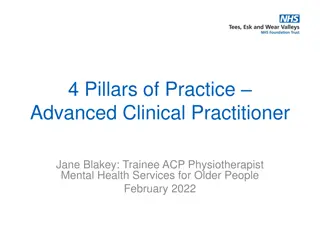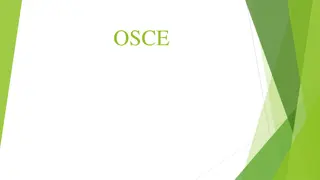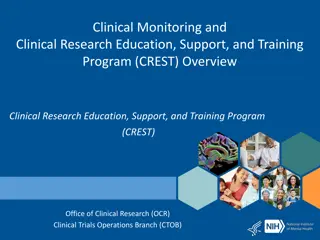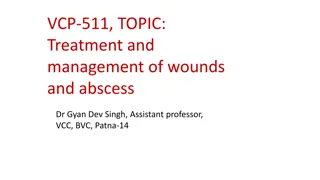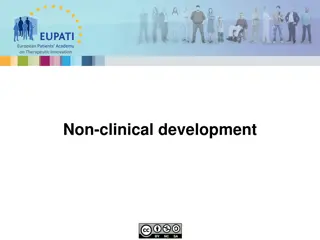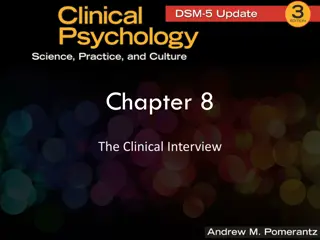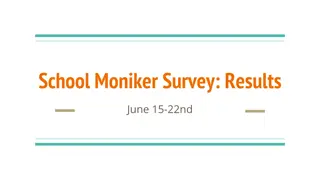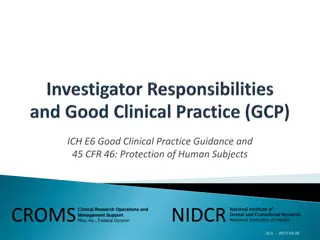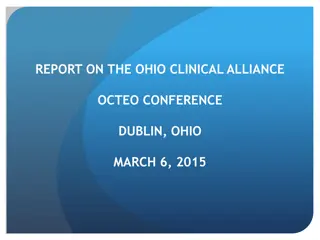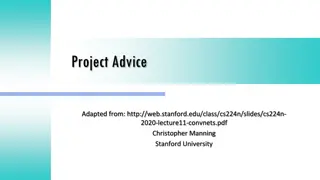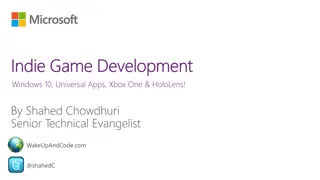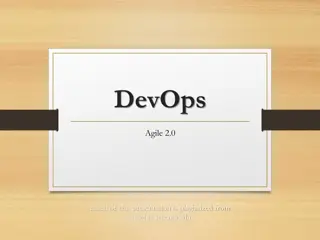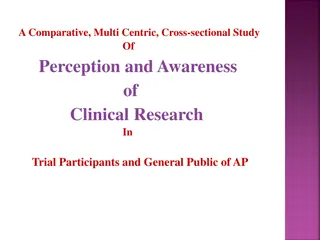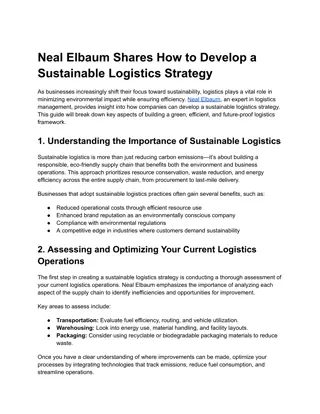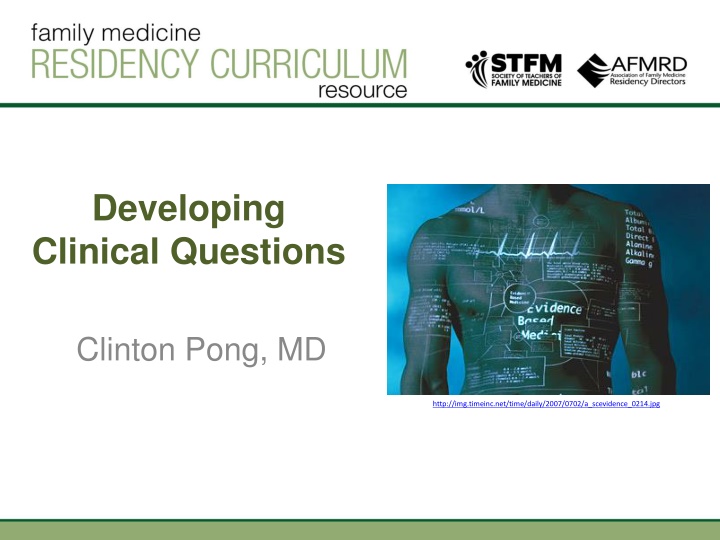
Developing Clinical Questions for Transgender Health
Explore the process of formulating clinical questions for transgender patients in healthcare settings. Learn the difference between background and foreground questions, and apply the PICO format to create actionable queries. Enhance your understanding of patient-oriented and disease-oriented evidence in medical practice.
Download Presentation

Please find below an Image/Link to download the presentation.
The content on the website is provided AS IS for your information and personal use only. It may not be sold, licensed, or shared on other websites without obtaining consent from the author. If you encounter any issues during the download, it is possible that the publisher has removed the file from their server.
You are allowed to download the files provided on this website for personal or commercial use, subject to the condition that they are used lawfully. All files are the property of their respective owners.
The content on the website is provided AS IS for your information and personal use only. It may not be sold, licensed, or shared on other websites without obtaining consent from the author.
E N D
Presentation Transcript
Developing Clinical Questions Clinton Pong, MD http://img.timeinc.net/time/daily/2007/0702/a_scevidence_0214.jpg
Introductory Case: A 45-year-old pansexual transgender man (with female body parts) with PMH of CIN I presents to your clinic for follow up. At last year s visit he was screened with a cervical pap smear and found to have the following result: Pap smear: ASCUS/HPV(+) Colposcopy with CIN I You recall from medical school that cervical pap smears are good for preventing cervical cancer, but you re not sure about the evidence about anal cancer surveillance and timing as it applies to this patient. You want to find this answer. This module will walk you through the process of developing a clinical question!
By the End of This Session, You Will be Able to: Explain the difference between: Background and foreground questions Differentiate between: Patient-oriented evidence and disease-oriented evidence Identify foreground questions and then apply the PICO format to create searchable clinical queries Population, Intervention/Comparison, Outcome
So, How Do I Develop a Clinical Question? Two types of questions: 1. Background Questions 2. Foreground Questions Background Questions Background questions asks who, what, where, when, why, or how about a single disease, drug, intervention, or concept EBM Basic Clinical Background Think of these as basic questions you might find from a textbook or a general EBM resource e.g., prevalence, ddx, pathophys, sensitivity/specificity of a test, med dosing/adverse reactions
Intro Case: Background Question Brainstorming What are some background questions that you can think of related to our patient with CIN I, as it relates to pap smears? Who What Where When Why How Some possibilities/suggestions: Where can I quickly find the most up to date guidelines for cervical cancer screening? For patients with high risk for anal cancer Is there any guidance on timing for surveillance? For patients with a cervix with hx of ASCUS What is the appropriate follow up based on X guideline with X level of evidence? What is the threshold for the callback for a Colposcopy or not based upon? Background Questions EBM Basic Clinical Background
So, How Do I Develop a Clinical Question? Two types of questions: 1. Background Questions 2. Foreground questions: Foreground questions ask for specific knowledge to inform a clinical issue on a specific patient, intervention or therapy If based on expert opinion or best practices, they are guidelines If based on EBM, they typically compare two things (or against placebo) in a research study: Diagnostic tests Drugs Treatments Foreground Questions General Resources e.g., Guidelines Research Studies
Information Mastery Resources, by Type: Background Questions Foreground Questions General Resources e.g., Guidelines EBM Research Studies Basic Clinical Background To Develop a Searchable Clinical Query, You need to formulate a foreground question in the PICO Format Medical Student Questions e.g., etiology, pathophys, pharmacology Resident Questions e.g., appropriate steps in workup and management (Based on BU and Dartmouth models)
The PICO Question Components Problem and Population What is the disease or condition? What are the important characteristics of my patient? Intervention What is the intervention I am looking for? Is it realistic (availability, cost, convenience, etc)? Is this different from how I currently practice? Comparison What is the alternative to the intervention? Outcome Is it something patients care about? Or is it something only physiologists/pharmacists care about? P I C O (Jackson, 2006; Flaherty, 2004)
How Do I Develop a Clinical Question? Focusing the PICO question 1. Population Starting with your patient, ask "How would I describe a group of patients similar to mine?" Be precise but brief. 2. Intervention/Comparison Ask What is the main intervention I am considering? and What is the main comparison/control? Be specific, but consider feasible alternatives. 3. Outcomes Ask "What can I hope to accomplish?" or "What could this exposure really affect? Select patient-oriented outcomes instead of the numbers (University of Oxford EBM Tools)
Intro Case: Foreground PICO Question Brainstorming Problem/Population P Intervention In adult patients with high risk sexual contact Does performing an anal cytological test and/or HPV test Comparison I C Outcome Compared to placebo OR Prevent development of anal cancer? Prevent development of anal precursor lesions O Are these outcomes our patient cares about?
The Patient is What Matters Disease-Oriented Evidence (DOE) Patient-Oriented Evidence That Matters (POEMs) Measure outcomes that are markers for disease. Silent numbers Measure outcomes that our patients care about. They have the potential to change the way we practice! (Slawson, 1994)
Characteristics of DOEs and POEMs Disease-Oriented Evidence (DOE) Patient-Oriented Evidence That Matters (POEMs) Morbidity Symptoms Daily function Mortality Quality of Life (as perceived by the patient) Pathophysiology Lab values Biochemical markers Pharmacology Plaque size Blood pressure Etiology (Slawson, 1994)
Examples of DOEs and POEMs Disease-Oriented Evidence (DOE) Patient-Oriented Evidence That Matters (POEMs) Intensive treatment can lower blood glucose levels in patients with type II diabetes Intensive treatment in patients with type II diabetes does not decrease mortality. Neither beat-carotene nor vitamin E prevent cardiovascular disease or cancer Beta-carotene and vitamin E are good antioxidants (Tufts, 2013)
Examples of DOEs and POEMs Disease-Oriented Evidence (DOE) The drug varenicline can help smokers stop smoking (which should lead to a decrease in cardiovascular events). Patient-Oriented Evidence That Matters (POEMs) Varenicline increases the risk of cardiovascular events. Older antiarrhythmic medications can decrease irregular heartbeats in patients with asymptomatic arrhythmias. Medical treatment of asymptomatic arrhythmias increases mortality by 10%. (Tufts, 2013)
Develop a DOE and a POEM for: Acute Otitis Media Patient-Oriented Evidence That Matters (POEMs) Evidence (DOE) Disease-Oriented Outcomes to focus on: time course, pain, complications and side effects of treatment Time course: Untreated AOM resolves by 1 week for 4 of 5 children Pain: Abx do not reduce pain at 1 day, but may reduce it at 2 and 7 days follow up (quality of life) Complications: Abx do NOT decrease incidence of mastoiditis Side effects: Abx cause rash, diarrhea and nausea with an equal likelihood as treatment success (quality of life) Treating children with antibiotics can sterilize the middle ear and treat bacterial acute otitis media This pathological/pharmological mechanism helps doctors determine treatment But it does NOT focus on morbidity, mortality, or quality of life In AOM, what do patients and parents really care about? (Hoberman 2011; Takata 2001; Thompson 2009)
Introductory PICO Question Patient In adult patients with high risk sexual contact Intervention anal HPV test Comparison Placebo Outcome Prevent development of anal precursor lesions? Is AIN an outcome our patient cares about? P = DOE I C O
Possible POEM Alternatives: In high-risk patients, are anal HPV tests associated with lower mortality rates from anal cancer? Or In high-risk patients, do anal HPV tests provide early detection and prevention of anal cancer? Or In high-risk patients, do early anal HPV tests prevent complications of treatment for late stages of anal cancer?
Alternate Clinical Queries After developing a best case-based PICO question, the next step is exploring other searchable clinical queries. These are a list of flexible alternative questions since the answer to your precise question may not match the current scientific literature. Typically, the alternatives involve reasonable variations of your interventions/comparison or alternative outcomes. P I C O
For the Next Three Cases, You Are Divided Up to Formulate the Following: 1. What are some background questions? 2. What are your foreground PICO questions? 1. Population "How would I describe a group of patients similar to mine?" 2. Intervention/Comparison Ask What is the main intervention I am considering? and What is the main comparison/control? 3. Outcomes Ask "What can I hope to accomplish?" or "What could this exposure really affect? Which outcomes are POEMs? Which outcomes are DOEs?
Case 1: A 55-year-old migrant farm worker presents to your clinic for follow up visit. A few weeks ago, at a health fair, she received a form inviting her for a mammogram and a cervical cancer screening. Today on follow up, her results are: HPV18(+), Atypical Glandular Cells You look at the ASCCP guidelines to guide management. She asks you: What should I do, doctor? (Perkins, RB. J Low Genit Tract Dis 2020)
Case 2: A 48-year-old Caucasian male construction worker without any significant PMH sees you for a routine physical exam. He reports that he is a 2 pack/day smoker for the past 30+ years and his father died of a heart attack at age 49. His blood pressure is 120/80 He brings in a lab report of his cholesterol: Total cholesterol: 200, HDL: 40, LDL 160 You use the ASCVD Risk Estimator+ equation http://tools.acc.org/ASCVD-Risk-Estimator- Plus/#!/calculate/estimate/ His 10-year risk to first ASCVD event is 7.7%. He asks you: do I need a cholesterol medication (statin)? (Lancet, Ridker, 2013)
Case 3: A 55-year-old right-handed female executive assistant presents to your clinic with numbness and pain in both hands, primarily in the thumb and index finger for the past year. She is worried now that she drops pens and paper more easily. She wears a wrist splint at night and takes Naproxen twice a day. She asks you about steroid injections that a co- worker told her about and wants to know if this could help her. (Atroshi, 2013; Marshall, 2007)
How Do I Develop a Clinical Question? 1. Think about a tough case Why was it difficult? Did any new or alternative decision points arise that you had not considered before? 2. List the questions you had and still have 3. Focus on a foreground question 4. Rephrase it into a PICO format P: Be precise but brief I/C: Be specific, but consider feasible alternatives O: Select patient-oriented outcomes instead of the numbers
Recount a Challenging Case From the Past Few Weeks What questions 1. Did your PATIENT ask? 2. Did YOU have while writing the SOAP note? 3. Did you ask your ATTENDING? 4. Still remain unresolved? List and label your questions as: background or foreground questions and POEMs or DOEs and then Brainstorm a PICO question with a partner.
PICO QuestionCase P- population I- intervention C- comparison group O- outcome (make it patient oriented) P I C O Answer?
Your Challenge For the next week, at the end of every day Write down a foreground PICO question based on your patients Focus on patient unmet needs [PUNs] To help you identify your (doctor s) educational needs [DENs]
Foreground Question Searches Developing Clinical Questions is just the beginning of information mastery on how to answer clinical questions. See the accompanying module on Finding Answers to Clinical Questions To minimize your work in selecting sources To locate valid and relevant information To maximize your learning in navigating information mastery search engines and resources To help you answer the questions you ve developed today!
The Usefulness Equation Usefulness of info source = Relevance x Validity Work needed Relevance Applicable to one s practice Focused on patient-oriented evidence that matters Validity This is where evidence-based medicine techniques are helpful Differences in study design and study conduct influence our comfort in the validity of the results Work Time, energy, and money needed to find the information In the clinic, aim for less than 1 minute Today s module helped you focus your questions to be FASTER and SMARTER when developing a question (Slawson, 1994)
Information Mastery Resources Background Questions Foreground Questions PubMed Clinical Queries TRIP Database Google Scholar Google site:.gov General Resources Research Studies Clinical Case-control Case-series Cohort studies Randomized Controlled Trials Critically- Appraised Topics Basic Clinical EBM Systematic Reviews Guidelines Background Medscape eMedicine Epocrates Lexicomp Evidence- Based Summaries Structured Abstracts Cochrane Library DynaMed Essential Evidence Plus Bandolier BMJ Clinical Evidence ACP Journal Club BMJ EBM Online Journal Watch Guideline.gov USPSTF/AHRQ Institute for Clinical Systems Improvement NICE-UK JAMA Rational Clinical Examination Symptom to Diagnosis EE+ Calculators (Based on BU and Dartmouth models)
Shared Decision-Making Medical Literature Appraise Read Apply Question Decide Patient Clinical Jazz = Traditional EBM + Shared Decision-Making (Structure) + (Improvisation) (Shaughnessy, 1998)
Congratulations! You Are Now Able To: Explain the difference between foreground and background questions. Differentiate between patient-oriented evidence and disease-oriented evidence. Identify a foreground question and apply the PICO format to create a searchable clinical query.
Resources AAFP. EBM Toolkit http://www.aafp.org/journals/afp/authors/ebm- toolkit/resources.html University of Oxford. EBM toolkit http://www.cebm.net/index.aspx?o=1023 PUNs and DENs worksheet http://www.networks.nhs.uk/nhs-networks/mk- impacte/documents/Puns%20and%20Dens%20boo klet%20v2.4.pdf
References Boston University School of Medicine. (2013) Curricular Innovations: Finding Information Framework. [Online] Available from: http://medlib.bu.edu/busm/fif/ and http://www.bumc.bu.edu/oaa/files/2013/10/BUSM-FIF.pdf [Accessed 11th November 2013]. Dartmouth College Biomedical Libraries. (2012) Evidence-Based Medicine Resources: Finding Evidence-Based Answers to Clinical Questions Quickly and Effectively. [Online] Available from http://www.dartmouth.edu/~biomed/resources.htmld/guides/ebm_resources.shtml and http://www.dartmouth.edu/~biomed/resources.htmld/guides/FindingGoodAnswers.pdf [Accessed 11th November 2013]. Tufts University School of Medicine: Department of Family Medicine: Center for Information Mastery: Concepts of Information Mastery. (2013). [Online] Available from http://medicine.tufts.edu/Education/Academic-Departments/Clinical-Departments/Family- Medicine/Center-for-Information-Mastery/Concepts-of-Information-Mastery [Accessed 11th November 2013]. University of Oxford. (2013) Centre for Evidence Based Medicine: EBM tools. [Online] Available from http://www.cebm.net/index.aspx?o=1023 [Accessed 11th November 2013]. Jackson R, et al. The GATE frame: critical appraisal with pictures. ACP Journal Club 2006 Mar/Apr: 144
References Atroshi I, Flondell M, Hofer M, Ranstam J. Methylprednisolone injections for the carpal tunnel syndrome: a randomized, placebo-controlled trial. Ann Intern Med 2013;159(5):309-17. Chan LS, Takata GS, Shekelle P, et al. Evidence assessment of management of acute otitis media: II. Research gaps and priorities for future research. Pediatrics2001;108:248-54. Chen CC, Chou YY. Predictive value of the anal cytology for detecting anal intraepithelial neoplasia or worse: A systematic review and meta-analysis. Diagn Cytopathol. 2019 Apr;47(4):307-314. doi: 10.1002/dc.24078. Epub 2019 Jan 3. PMID: 30605263. Egemen D, Cheung LC, Chen X, et al. Risk estimates supporting the 2019 ASCCP Risk Based Management Consensus Guidelines. J Low Genit Tract Dis 2020; 24:132-43. Flaherty RJ. A simple method for evaluating the clinical literature. Fam Pract Manag 2004 May;11(5):47-52. Marshall SC, Tardif G, Ashworth NL. Local corticosteroid injection for carpal tunnel syndrome. Cochrane Database Syst Rev 2007;2: CD001554. Perkins RB, Guido RS, Castle PE, et al. 2019 ASCCP risk-based management consensus guidelines for abnormal cervical cancer screening tests and cancer precursors. J Low Genit Tract Dis 2020; 24:102-31 Ridker PM, Cook NR. Statins: new American guidelines for prevention of cardiovascular disease. Lancet2013;13: 62388-0. Slawson D, Shaughnessy A, Bennett J. Becoming a medical information master: feeling good about not knowing everything. J Fam Pract 1994;38(5):505-13. Slawson D, Shaughnessy A, Bennett J. Becoming an information master: a guidebook to the medical information jungle.J Fam Pract 2004;39(5):489-99. Shaughnessy AF, Slawson DC, Becker L. Clinical jazz: harmonizing clinical experience and evidence-based medicine. JFam Pract1998;47:425-8. Thompson PL, Gilbert RE, Long PF, Saxena S, Sharland M, Wong IC. Effects of antibiotics for otitis media on mastoiditis in children: a retrospective cohort study using the United Kingdom General Practice Research Database. Pediatrics 2009; 123(2):424-30.




